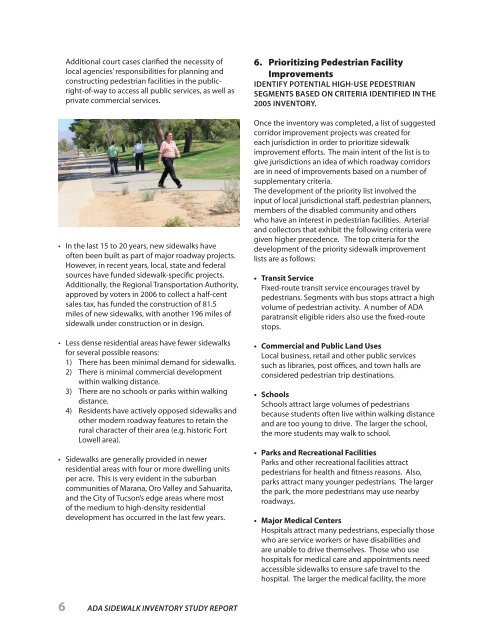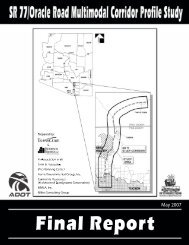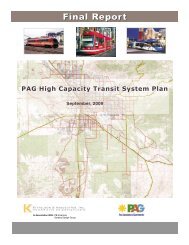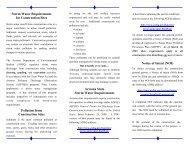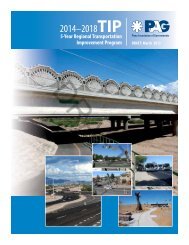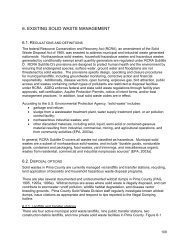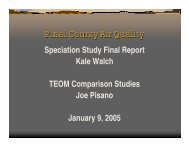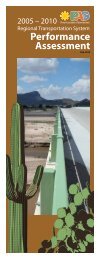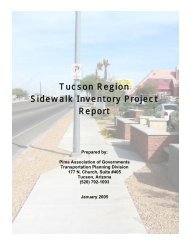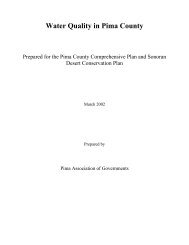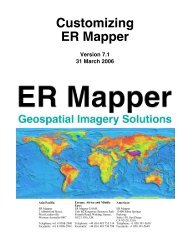2012 Sidewalk Inventory Report - Pima Association of Governments
2012 Sidewalk Inventory Report - Pima Association of Governments
2012 Sidewalk Inventory Report - Pima Association of Governments
Create successful ePaper yourself
Turn your PDF publications into a flip-book with our unique Google optimized e-Paper software.
Additional court cases clarified the necessity <strong>of</strong><br />
local agencies’ responsibilities for planning and<br />
constructing pedestrian facilities in the publicright-<strong>of</strong>-way<br />
to access all public services, as well as<br />
private commercial services.<br />
<br />
<strong>of</strong>ten been built as part <strong>of</strong> major roadway projects.<br />
However, in recent years, local, state and federal<br />
sources have funded sidewalk-specific projects.<br />
Additionally, the Regional Transportation Authority,<br />
approved by voters in 2006 to collect a half-cent<br />
sales tax, has funded the construction <strong>of</strong> 81.5<br />
miles <strong>of</strong> new sidewalks, with another 196 miles <strong>of</strong><br />
sidewalk under construction or in design.<br />
<br />
for several possible reasons:<br />
1) There has been minimal demand for sidewalks.<br />
2) There is minimal commercial development<br />
within walking distance.<br />
3) There are no schools or parks within walking<br />
distance.<br />
4) Residents have actively opposed sidewalks and<br />
other modern roadway features to retain the<br />
rural character <strong>of</strong> their area (e.g. historic Fort<br />
Lowell area).<br />
<br />
residential areas with four or more dwelling units<br />
per acre. This is very evident in the suburban<br />
communities <strong>of</strong> Marana, Oro Valley and Sahuarita,<br />
and the City <strong>of</strong> Tucson’s edge areas where most<br />
<strong>of</strong> the medium to high-density residential<br />
development has occurred in the last few years.<br />
6. Prioritizing Pedestrian Facility<br />
Improvements<br />
IDENTIFY POTENTIAL HIGH-USE PEDESTRIAN<br />
SEGMENTS BASED ON CRITERIA IDENTIFIED IN THE<br />
2005 INVENTORY.<br />
Once the inventory was completed, a list <strong>of</strong> suggested<br />
corridor improvement projects was created for<br />
each jurisdiction in order to prioritize sidewalk<br />
improvement efforts. The main intent <strong>of</strong> the list is to<br />
give jurisdictions an idea <strong>of</strong> which roadway corridors<br />
are in need <strong>of</strong> improvements based on a number <strong>of</strong><br />
supplementary criteria.<br />
The development <strong>of</strong> the priority list involved the<br />
input <strong>of</strong> local jurisdictional staff, pedestrian planners,<br />
members <strong>of</strong> the disabled community and others<br />
who have an interest in pedestrian facilities. Arterial<br />
and collectors that exhibit the following criteria were<br />
given higher precedence. The top criteria for the<br />
development <strong>of</strong> the priority sidewalk improvement<br />
lists are as follows:<br />
<br />
Fixed-route transit service encourages travel by<br />
pedestrians. Segments with bus stops attract a high<br />
volume <strong>of</strong> pedestrian activity. A number <strong>of</strong> ADA<br />
paratransit eligible riders also use the fixed-route<br />
stops.<br />
<br />
Local business, retail and other public services<br />
such as libraries, post <strong>of</strong>fices, and town halls are<br />
considered pedestrian trip destinations.<br />
<br />
Schools attract large volumes <strong>of</strong> pedestrians<br />
because students <strong>of</strong>ten live within walking distance<br />
and are too young to drive. The larger the school,<br />
the more students may walk to school.<br />
<br />
Parks and other recreational facilities attract<br />
pedestrians for health and fitness reasons. Also,<br />
parks attract many younger pedestrians. The larger<br />
the park, the more pedestrians may use nearby<br />
roadways.<br />
<br />
Hospitals attract many pedestrians, especially those<br />
who are service workers or have disabilities and<br />
are unable to drive themselves. Those who use<br />
hospitals for medical care and appointments need<br />
accessible sidewalks to ensure safe travel to the<br />
hospital. The larger the medical facility, the more<br />
6 ADA SIDEWALK INVENTORY STUDY REPORT


